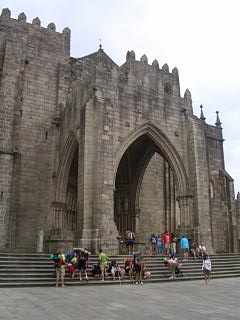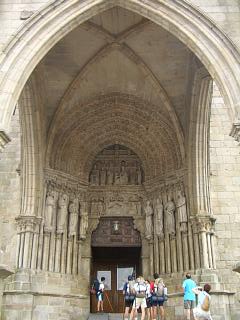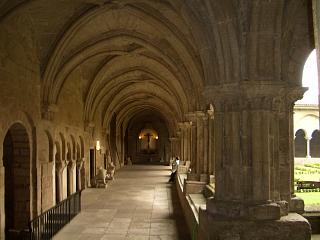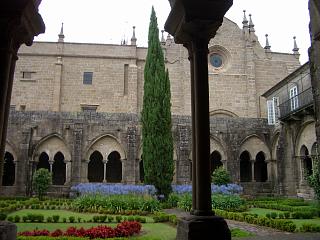Tui Cathedral
Tui cathedral, unlike the basilicas of Pontevedra, Ferrol and Vigo, is exactly that (a real cathedral) and Tui can
 genuinely lay claim to the title of city. The building was consecrated in 1225 AD during the monarchy of King Alfonso, but building work started over a century earlier.
genuinely lay claim to the title of city. The building was consecrated in 1225 AD during the monarchy of King Alfonso, but building work started over a century earlier.
The cathedral really is a monumental structure and its position, on top of a hill at the summit of the town, makes it the emblem of the city.
The building is actually a castle cathedral and the walls are adorned with battlements and fortifications, some dating back to the year 1120 AD when building work first commenced. The best view of he Cathedral de Tui is to be had from a spot somewhere close to the banks of the Mino in the valley below. It is from this position that you can get an uninterrupted sightline looking up to the once walled town with the cathedral perched at the top.
Once close to the cathedral it becomes impossible to get that all encompassing view.
 The cathedral is surrounded by other buildings and that, combined with its shear size, mean that you only ever manage restricted glimpses of certain sections of the construction.
The cathedral is surrounded by other buildings and that, combined with its shear size, mean that you only ever manage restricted glimpses of certain sections of the construction.
The proportions of the building are however not lost and its scale and grandeur remain just as imposing as you stand in front of the main portico. This portico has aesthetic and historic importance. As a piece of architecture and masonry it is incredibly detailed and one awes at the thousands of man hours that must have gone into its making, but it also represents the first instance of Gothic art in Spain. Other elements of the building are also Gothic, but the oldest sections and main architectural styling are Romanesque.
Once inside the cathedral, for which a one euro charge is levied, the internal
 embellishments are more than equal to those of the façades. The cathedral has a small museum (in the chapel of Saint Catherine), but it is the cloisters (see right), vaulting, columns, altars and stone and timber carvings that impress the most. A massive organ and choir are other important features, but it is the overall scale and spectacle that make the biggest impression. Unusually, flash photography is allowed in all areas.
embellishments are more than equal to those of the façades. The cathedral has a small museum (in the chapel of Saint Catherine), but it is the cloisters (see right), vaulting, columns, altars and stone and timber carvings that impress the most. A massive organ and choir are other important features, but it is the overall scale and spectacle that make the biggest impression. Unusually, flash photography is allowed in all areas.
Once you have wondered around the numerous chapels and admired the glistening altars, a stair off the main cloister takes you up into the building or out and onto a mirador
 (viewing point). Both options offer great views across to Portugal and the town of Valenca with the river Mino below.
(viewing point). Both options offer great views across to Portugal and the town of Valenca with the river Mino below.
If you climb the stair up to the battlements you walk around and above the main cloister and also gain another perspective on the scale of the cathedral.
We spent about an hour looking around the cathedral and although the museum element was limited, the rest of the building more than warranted the tiny charge of one euro per head.
Left, the gardened courtyard within the cathedral.

